What We Learned From Taylor Swift’s “Bad Blood” Marketing Campaign
Sunday night saw the world watch as musicians from every corner of entertainment came together for the Billboard Music Awards. It was an event that had been promoted for weeks, and it was filled with as many headline-worthy moments as promised, including the world premiere of Taylor Swift’s long-awaited “Bad Blood” music video.
Guest Post by James Shotwell on The Official Blog of Haulix
Whether or not you were satisfied with the final result is a conversation for another time, but in this piece we will look at the video’s promotional campaign, debut, and the way it was received by fans to determine what, if anything, smaller performers can learn from Ms. Swift’s efforts.
BACKGROUND:
“Bad Blood” is the fourth single off Swift’s critically-acclaimed fifth studio album, 1989, following the successful promotional runs for “Style,” “Blank Space,” and “Shake It Off.” The single version, which features two verses from rapper Kendrick Lamar, was not shared with the public prior to the video’s release. In fact, the song that premiered on May 19 sounds like quite a departure from the source material fans likely expected to hear in the video. Here’s the original version (as performed live, since there is no public stream available of the studio cut):
We’ll get to the new version in a bit, but keep in mind that this is what fans were expecting. Not meeting those expectations is only a bad thing if what you deliver instead is viewed as somehow being subpar in regards to quality. I’m not saying that is the case with the new cut of “Bad Blood,” but promoting the release of a song that fans know to sound one way and then sharing something unquestionable different is a risky move. If it works, great. If it doesn’t, the trust your fans place in your marketing may be soiled.
To date, Taylor’s 1989 album has sold 4.5 million copies, which is better than even her own previous two records. You may not like her music, but you cannot deny that she has more international appeal than essentially everyone else in music today. She sets the bar for pop musicians today just like she used to set the bar for country artists, and with the release of the hip-hop meets power-pop sound of “Bad Blood” it seems she is trying to change the game once more.
PROMOTION:
Taylor Swift does not really need to promote her music endeavors as everyone in the world is already watching to see what she does next, but she does so anyways, and the campaign leading up to the release of “Bad Blood” was her largest yet. Since early April Swift has been uploading and sharing promotional images for the video that featured the numerous guests, as well as their role(s) in the video, designed in a style similar to theatrical posters for films like Kill Bill or Sin City. Everyone from Paramore vocalist Hayley Williams, to Law And Order: SVU star Mariska Hargitay made the cut, including famous faces like Pitch Perfect 2breakout Hailee Seinfeld, modeling icon Cindy Crawford, and Girls creator/star Lena Dunham. Each reveal coincided with a surge in press attention, which would last just long enough for Swift to prepare and release yet another promotional image. There were 16 images/guests in total.
No video clips were teased ahead of the official music video release. No plot was revealed either, but fans were able to speculate based on the various names given to the characters. Jessica Alba, for example, was known as Domino. Hayley Williams, who appeared with red hair, was called The Crimson Curse.
DEBUT:
As promised, Taylor’s video for “Bad Blood” premiered at the top of the 2015 Billboard Music Awards. Those who tuned in to watch the live broadcast were the first in the world to view the clip, but CBS wisely made a high quality video stream available immediately following the premiere. Sites embedded that clip instantaneously, and soon word of the video’s arrival online began to circulate on social networking sites. You can view the final video, in full, below:
Now remember: The premiere of this video marked the first time anyone had heard the Kendrick Lamar assisted remix of “Bad Blood.” In fact, it was the first time anyone knew such a track even existed. Like the contents of the video itself, no one knew what to expect from the song almost as soon as it began. To say it was a lot for people to take in would be an understatement.
REACTIONS:
As you can probably guess, the media was quick to try and cash in on the ridiculous nature of the video, as well as its many guest stars and special effects:


Many fans were also quick to jump on the love train, praising everything from the new remix to the ‘feminist heroes’ that appeared in the video:
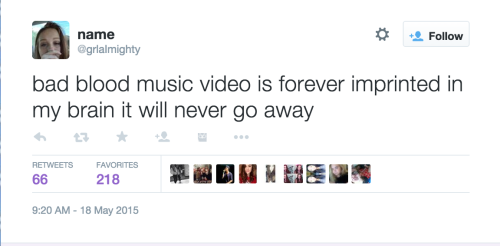
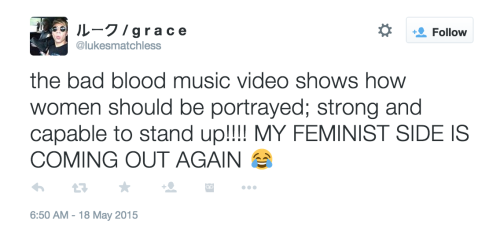
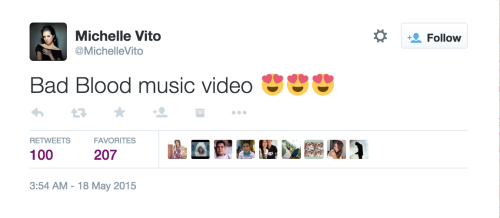
Of course, there were haters as well. Some people didn’t see the point of the video, while others thought the updated track lacked soul:
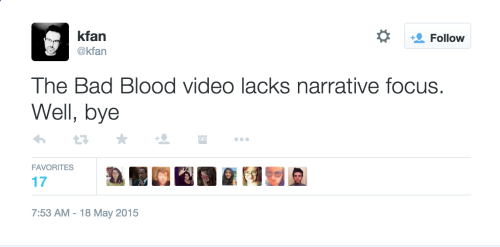

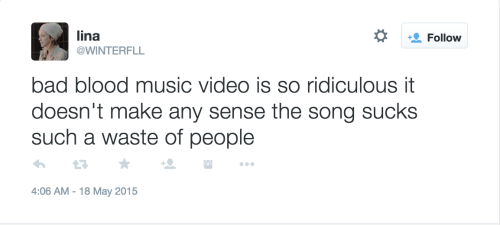
I don’t know if there is anything to learn from this aside from the fact that everyone has an opinion, but it does feel safe to say not everyone is in love with the latest move from Taylor Swift. That isn’t a bad thing necessarily, as there is no way Ms. Swift can be expected to please everyone, but it does lead us to ask what did and did not work about her “Bad Blood” campaign.
HERE’S WHAT WORKED:
“Bad Blood” was considered a massive success before the video or remix even debuted thanks entirely to its promotional campaign. Without showing a single frame of the finished product Taylor Swift was able to make her global fan base excited about the promotion of a song most already owned and had long committed to memory. The promotional posters played a large role in this effort, and they also proved that it is possible to gain multiple headlines every single week for promoting something as long as the promotion itself is unique and engaging. Most publications don’t cover video teasers, especially when said teasers number in the teens, but Swift and her team were able to create a sense of mystery around “Bad Blood” that took the media by storm. The guest stars helped, no doubt, but from the reveal of Swift’s only promotional poster it was clear “Bad Blood” would mark a turning point in the vocalist’s career. Fans knew almost immediately that the video would stray far from the romantic narratives that have driven many of Swift’s best videos, and that alone was enough to cause near constant conversation around the video’s release for more than a month before the clip even premiered.
Also, the decision to premiere “Bad Blood” during the Billboard Music Awards was smart as it exposed Taylor’s latest evolution to the largest crowd possible during one of music’s biggest nights. The Swift brand is a global sensation, but its unquestionable dominance here in the states. By premiering atop the awards show Swift reaffirmed her role as pop’s current queen, and she more or less cemented her place among radio royalty for the rest of time. Everyone with even a passing interested in pop music tuned in last night, and everyone who didn’t almost assuredly saw the video mentioned online. To permeate the global pop culture conversation any further seems impossible.
HERE’S WHAT DIDN’T WORK:
Like a summer blockbuster that begins advertising more than six months before its release, the hype established for the premiere of “Bad Blood” set expectations for the clip through the roof. The large number of cameos lead many to believe Taylor would unveil something akin to a short film, but in reality the clip played more like a sizzle reel from an unreleased action film that lacked both plot and cohesive thought. Very few scenes in the video have much, if anything, to do with every other scene. It’s as if the video was chopped together with the sole intention of featuring as many notable female celebrities as possible. So much so that any notion of narrative direction was completely tossed out the window. What is this agency where Swift works? Who is the bad guy? Why are they bad and Swift’s team good? Who keeps a rocket launcher in a locker room? Why is the world on fire? Why does Mariska Hargitay walk down a tunnel with Taylor, seemingly headed to battle, only to be absent from the actual war sequences? It’s all flashy and insanely well edited, but when you step back and think about what is actually unfolding on screen it’s a lot of interesting ideas that never really amount to anything at all.
Furthermore, the remix of “Bad Blood” feels and sounds more like a Kendrick Lamar single featuring Taylor Swift than a Swift original, which is quite a strange turn of events. Lamar has not one, but two verses, and Swift barely appears outside of the hook and bridge. It’s a decision that seems to have been made with the goal of making “Bad Blood” something that could dominate radio during the height of a summer heatwave, but in doing so the song seems to have lost much of what made it so special in the first place. Storytelling has long been the heart and soul of Taylor Swift’s career, but neither this remixed track nor its accompanying video has anything unique to say. It’s pretty, and it’s no doubt worthy of headlines, but in terms of substance and depth you’re basically dealing with a puddle on a hot July day.
WHAT UP AND COMING ARTISTS SHOULD LEARN FROM ALL THIS:
The chances of your next video premiere capturing the attention of media around the globe are far lower than those of Taylor Swift, but that doesn’t negate the fact that there is a lot you can learn from her recent promotional efforts. The success of the “Bad Blood” campaign was not built on the strength of the song itself, but rather the way it would be complimented by the official video. The posters Taylor released, while no doubt created in part to leverage the popularity of the clip’s guest stars, served to engage Swift’s fans on a regular basis with fresh, easy to duplicate content that never felt too overwhelming. You can do the same thing with your next campaign, be it a tour or a video or even a new song. You can share scenes from your experience (studio life, road life, show life, behind-the-scenes at a video shoot, etc.) along with release information. Make it unique by any means necessary, but make sure whatever you do not only represents the item being promoted, but you as an artist as well. Fans know when you’re not presenting yourself honestly, and in the digital age no one is afraid to call you out on such misguided decisions.
If you can find a way to present yourself in a new and unique way each time you present something new then you can win over people from all walks of life with each reveal. The possibilities for achieving this are limitless, but they must be done to the best of your abilities to be successful. Like lying about your true self, fans can see through cheap promotions, and again they will not hesitate to call you out. If you want to be successful in art you must commit yourself fully to whatever it is you want to do, and that extends to promotion of said endeavor. Taylor Swift has done just that with “Bad Blood,” and regardless of how you feel about the final product you cannot deny that people around the world are actively engaged with her brand. You can do the same. I believe in you.
James Shotwell is the Marketing Coordinator for Haulix. He is also a professionalentertainment critic, covering both film and music, as well as the co-founder of Antique Records. Feel free to tell him you love or hate the article above by connecting with him onTwitter. Bonus points if you introduce yourself by sharing your favorite Simpsons character.